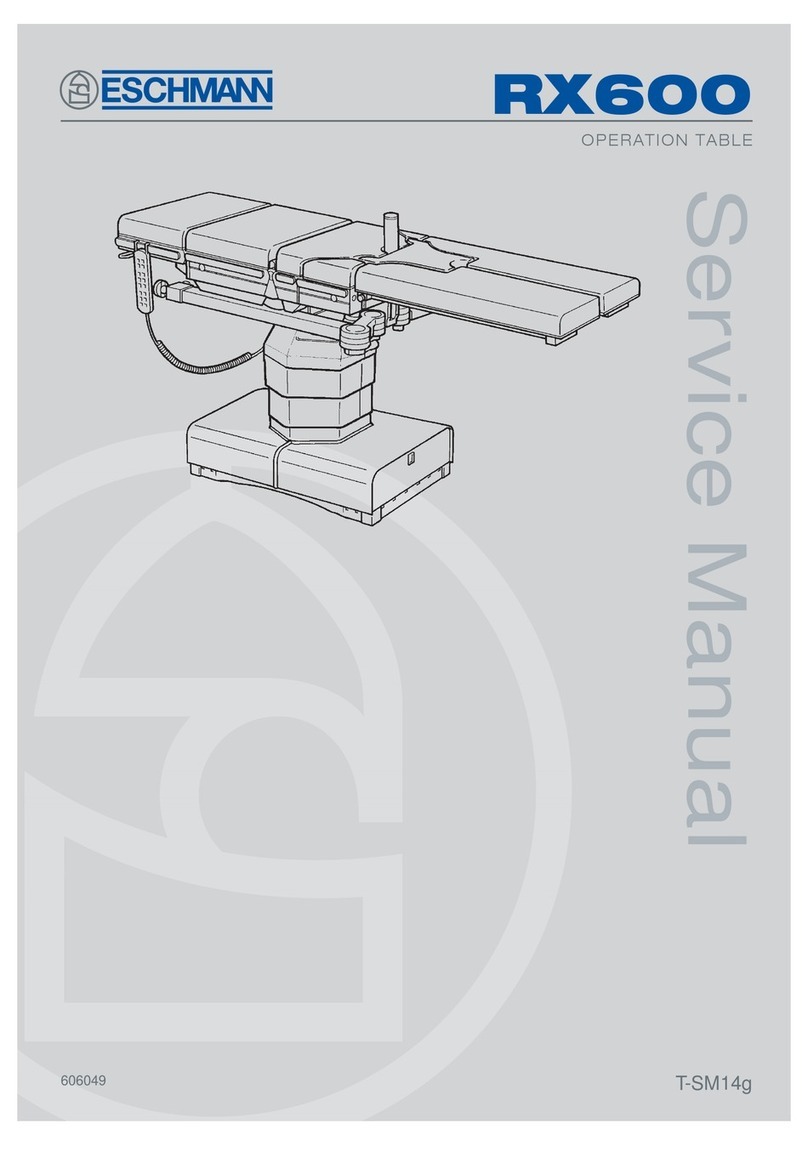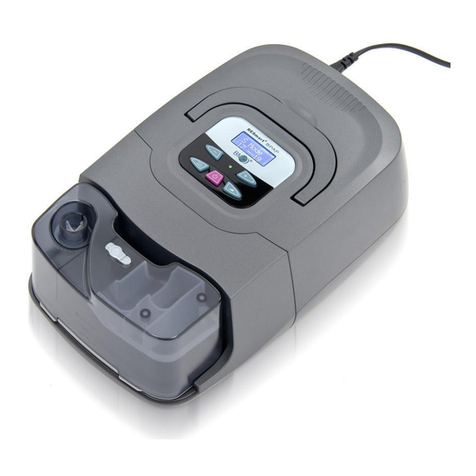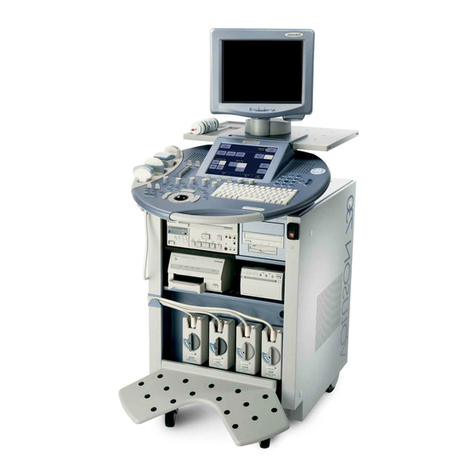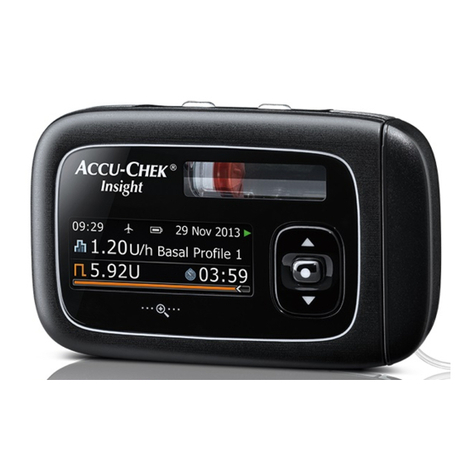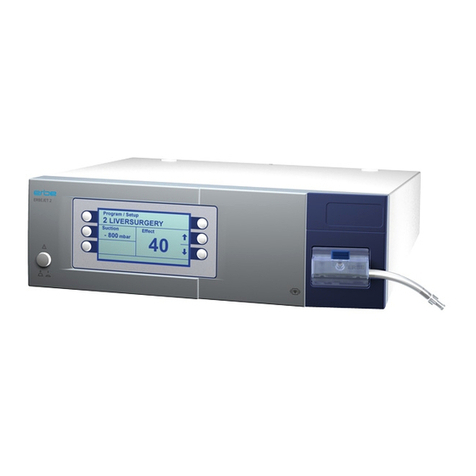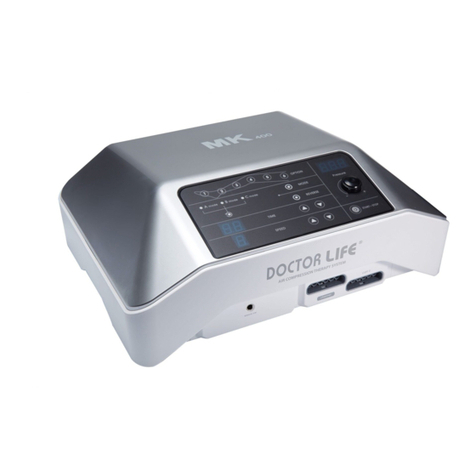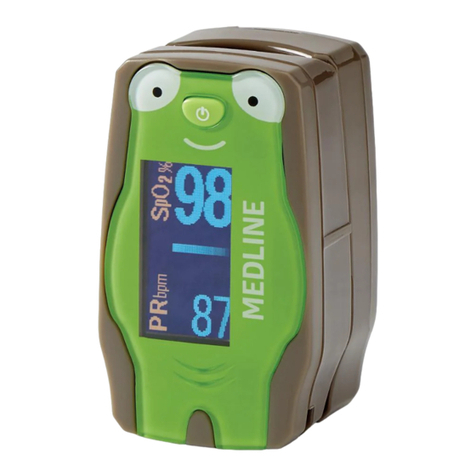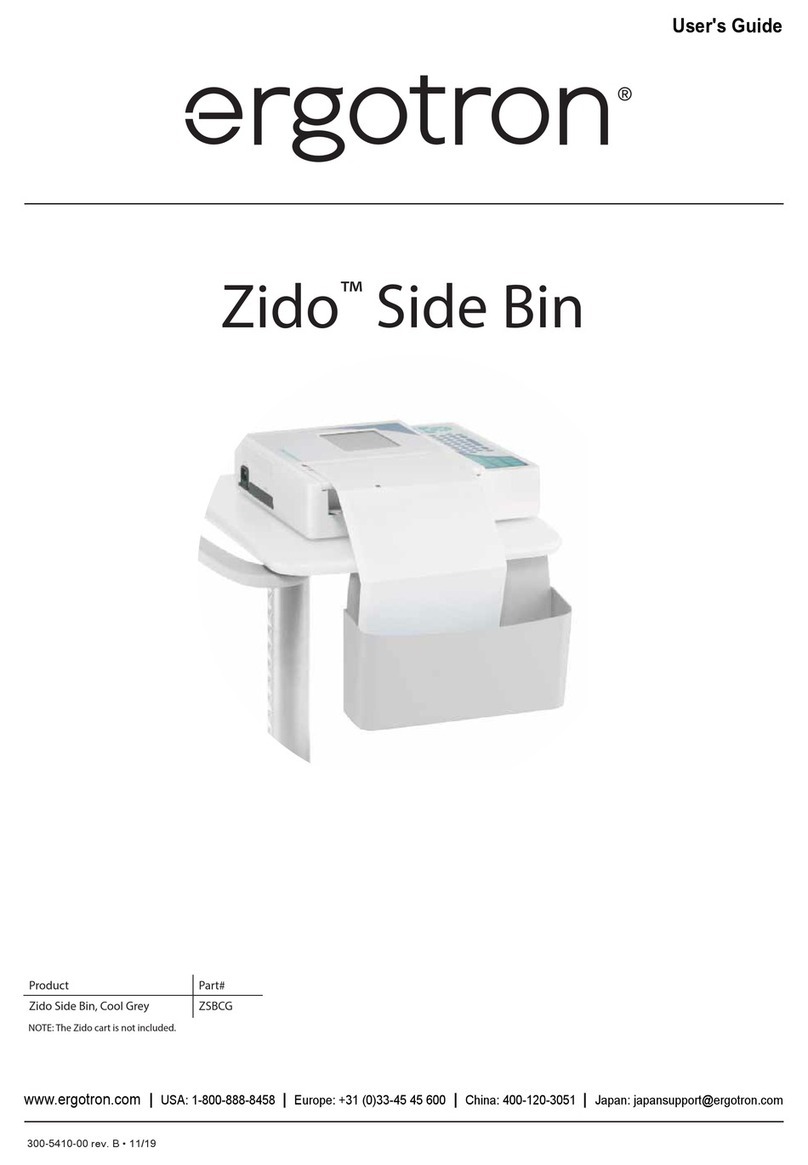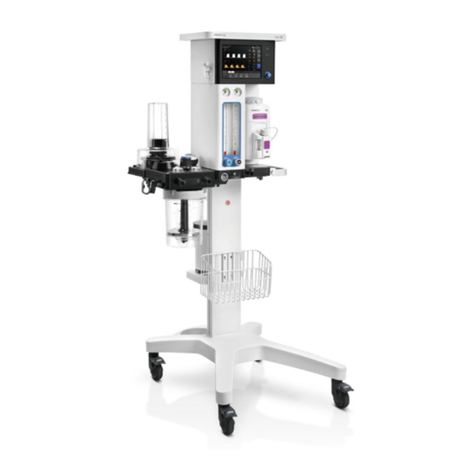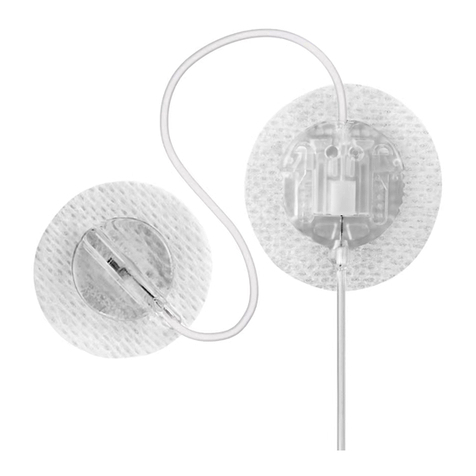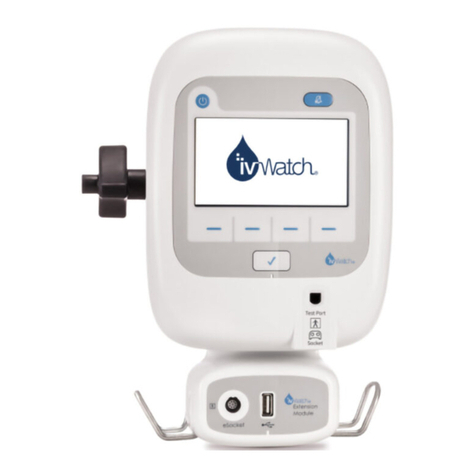Critikon DINAMAP PRO 1000 User manual

PRO 1000
PRE-SERVICE AND
CALIBRATION
MANUAL

DINAMAPPRO 1000 Monitor
Pre-Service & Calibration Manual

List of Effective Pages
Part No./Rev. Page No. Date of Latest Revision
2008384 All Original (Oct. 2001)
U.S. Patent 5,170,795 U.S. Patent 4,349,034
U.S. Patent 5,052,397 U.S. Patent 4,360,029
U.S. Patent 4,754,761 U.S. Patent 4,501,280
U.S. Patent 4,638,810 U.S. Patent 4,546,775
U.S. Patent 4,543,962 U.S. Patent 5,518,000
U.S. Patent 5,704,362 Patents Pending
CAUTION: Federal (U.S.A.) law restricts this device to sale
by or on the order of a health care practitioner
The content of this document, including all figures and
drawings, is proprietary information of General Electric
Medical Systems Information Technologies, provided
solely for purposes of operation, maintenance or repair of
PRO Series 1000 Monitors.
Dissemination for other purposes or copying thereof
without the prior written consent of General Electric
Medical Systems Information Technologies, Tampa,
Florida, is prohibited. Illustrations may show design
models; production units may incorporate changes.
2001 TAMPA, FL 33614
Printed in the U.S.A. All rights reserved.
United States
General Electric Medical Systems Information Technologies
4502 Woodland Corporate Boulevard
Tampa, FL 33614
EU Representative
General Electric Medical Systems Information Technologies
GmbH
Munzinger Strasse,
Freiburg, Germany
ii

SECTION 4. GENERAL MAINTENANCE
Contents
4.1. Introduction ......................................................................................................4-3
4.2. Configuring the PRO 1000 Monitor for the First Time ......................................4-3
4.2.1 Unpacking and Preparation for Installation..................................................4-3
4.2.2 Set the Date and the Clock .........................................................................4-5
4.2.3 Parameter Level Functional Testing............................................................4-6
4.3. Periodic Maintenance ......................................................................................4-7
4.3.1. As Required ...............................................................................................4-7
4.3.1.1 Integrity of Cuffs and Hoses ..................................................................4-7
4.3.1.2 External DC Supply and Battery ............................................................4-7
4.3.1.3 Cleaning of Accessories ........................................................................4-7
4.3.1.4 Long Term Storage................................................................................4-8
4.3.2 Annual Procedures......................................................................................4-8
4.4. Care of Storage Batteries ..............................................................................4-9
4.4.1. Procedures for First Use ............................................................................4-9
4.4.2 Battery Charging .........................................................................................4-9
4.5 Safety Resistance Testing ............................................................................. 4-12
4.6. Alarm Code Interpretation .......................................................................... 4-14
4.6.1. System Failures....................................................................................... 4-14
4.6.2. Hardware Errors...................................................................................... 4-15
4.6.3. Parameter Failures.................................................................................. 4-15
4.6.3.1 ECG/RESP Errors .............................................................................. 4-15
4.6.3.2 NIBP Messages.................................................................................. 4-15
4.6.3.3 Temperature Messages...................................................................... 4-16
4.6.3.4 SpO2 Messages ................................................................................. 4-16
4.7. Service Mode Operation............................................................................. 4-16
4.7.1 SpO2 Tests .............................................................................................. 4-19
4.7.2 NIBP Tests ............................................................................................... 4-20
4.7.2.1 Leak Test............................................................................................ 4-21
4.7.2.2 NIBP Calibration Check ...................................................................... 4-23
4.7.2.3 Pressure Recalibration ....................................................................... 4-24
4.7.2.4 Overpressure Test.............................................................................. 4-25
4.7.3 ECG Tests................................................................................................ 4-27
4.7.4 Temp Tests .............................................................................................. 4-28
4.7.5 Recorder Tests......................................................................................... 4-30
4.7.6 Battery Tests ............................................................................................ 4-31
4.7.7 Test Failsafe Logic ................................................................................... 4-32
4.7.8 Keypad LED Test ..................................................................................... 4-33
4.7.9 Keypad Key Test ...................................................................................... 4-33
4.7.10 Sound Test............................................................................................. 4-33
4.7.11 Turn off the System ................................................................................ 4-33
4.8 Service Mode Exit .......................................................................................... 4-33
Appendix A - Test Record
Appendix B – Monitor Configuration Log
4-1

This page intentionally left blank.
4-2

SECTION 4. GENERAL MAINTENANCE
4.1 INTRODUCTION
This section contains general Monitor service procedures, including alarm code
interpretation, service mode operation, and periodic maintenance and battery care.
Refer to Section 5 for disassembly and reassembly procedures and related
component service information.
4.2 Configuring the PRO 1000 Monitor for the First Time
4.2.1 Unpacking and Preparation for Installation
1. Unpack and identify the contents of all shipping materials.
2. Remove the PRO 1000 monitor.
3. Unpack the AC cord but do not plug the monitor in at this time.
4. Turn the monitor for access to the Host Comms Cover.
5. Use a Phillips-head screwdriver to remove the single screw that secures the
Host Comms cover.
6. The Battery fuse and the Fuse Holder are not connected at time of shipment.
Locate and remove the fuse and fuse holder from the protective plastic bag.
7. Identify the Battery Fuse holder located within the Host Comms well, near the
lower left side.
8. Insert the Battery Fuse into the Battery Fuse holder
9. Press the Battery Fuse Holder into the Battery Fuse mount using thumb
pressure until it is securely snapped in place.
10. Replace the Host Comms cover; refasten the Phillips screw. Tighten using
hand-tools only.
11. Plug the AC cord into the AC Mains input at the back of the monitor.
12. Plug the AC cord into a Hospital Grounded AC receptacle. A green LED will
illuminate on the front of the monitor indicating that an AC source is available.
Prior to usage it is necessary to charge the monitor for 12 hours. This
charge calibrates the battery charging circuitry with the charge status of
the battery.
4-3

4-4

4.2.2 Set the Date and the Clock
The DINAMAP® PRO 1000 monitor uses a rotor knob to navigate through the
menu systems. Rotating the rotor moves the arrow cursor, and pressing the rotor
makes the selection.
1. Power on the PRO monitor using the OFF/ON key
2. Choose no when the monitor prompts to admit a new patient
3. Press or turn the rotor to access the main menu.
4. Turn the rotor and press to select other system settings option.
5. Turn the rotor and press to select go to config mode option.
6. Turn the rotor and press yes to continue to Configuration Mode.
7. The PRO Monitor will now prompt for the Configuration Mode password.
8. Turn the rotor and press to select after each numeral of the password is
selected.
9. The password to enter the configuration mode is 2-5-0-8.
10. Following the password entry, turn the rotor and press to select done.
11. In the process of entering the Configuration Mode, the PRO 1000 monitor will
reset. Successful entry into the Configuration Mode can be noted by the
words CONFIGURATION MODE in red capital letters at the top-center of the
screen.
12. Turn the rotor and press to select other system settings.
13. Turn the rotor and press to select config settings…
The Options available within this menu are:
• Select Date Format – Press the rotor to choose the order Month, Day, and
Year appears
• Select Time Format – Press the rotor to choose either a 12-hour clock or a
24-hour clock.
• Adjust Date & Time – Press the Select Knob to enter the correct Date and
Time. After setting the date and the time, make sure to press set new time
and date to save.
• Language – Press the rotor to choose a different language.
• Display Units – Choose yes to display all units of measure.
• Display Limits – Choose yes to display all alarm units.
• Reset all to Factory – CAUTION: resets all user-set options to the factory
defaults. Yes enables.
• Send all defaults – Choose this option sends all defaults to another
connected PRO 1000 monitor through the Host Communications ports.
4-5

4.2.3 Parameter Level Functional Testing
After the initial configuration is complete, perform functional testing of each of the
parameters. Using the accessories supplied with the PRO Monitor, initialize the
monitor in such a way that only one parameter is functioning at a time.
• Perform a blood pressure by connecting the
supplied hose and cuff together, then attaching
to the left side of the PRO Monitor. Press the
Start Key on the front to begin the NIBP cycle.
• Connect the supplied temperature probes to the
corresponding connections (see right). A
predictive temperature will begin once one
probe is removed from its’ holster. Replace the
probe after completion of the Temp cycle.
• The SpO2sensor is an assembly consisting of
two parts: the DS-100A, and the extender cable
SCP-10. Connect the cables prior to attaching
to the monitor. A SpO2reading will be displayed
within moments of attaching the sensor to either
a Nellcor simulator or to your finger.
• Connect the ECG lead connector to the ECG trunk cable prior to connecting
to the monitor. The simplest way to function test the ECG circuits is through
the usage of an ECG simulator.
1. Set your simulator to normal heart rate.
2. Set ECG amplitude to 1.5mV, BPM to 80.
3. Set respirations to 20 RPM, delta ohms to 1.0.
4. Verify that the ECG waveform is displayed.
5. Remove and reattach leads I, II, and III sequentially, and verify that
LEAD OFF is displayed.
6. From the ECG menu, select turn parameter off.
4-6

4.3 PERIODIC MAINTENANCE
4.3.1 As Required
Perform the following maintenance procedures as required.
4.3.1.1 Integrity of Hoses and Cuffs
When the pneumatic integrity of any NIBP cuff and hose is in doubt, replace the
cuff and hose, and discard the questionable accessories.
4.3.1.2 Cleaning of Monitor
CAUTION: Do not clean Monitor with isopropyl alcohol or other
solvents.
Wipe the exterior of the Monitor with a cloth slightly dampened with mild
detergent or normal hospital bactericides. Use dishwashing detergents such as
IVORY and JOY (registered trademarks of Procter & Gamble Corp.), or
PALMOLIVE (registered trademark of Colgate-Palmolive Corp.)
Do not immerse unit.
4.3.1.3 Cleaning of Accessories
Clean the adult cuffs supplied for use with the monitor by hand washing in
warm, soapy water. However, take care to avoid entry of water into the cuff and
hoses at any time. If water enters the cuff, dry the cuff by passing air through it.
The neonatal cuffs are for single patient use - discard if they become soiled.
Clean cuffs and hoses with a cloth slightly dampened with mild detergent.
Do not immerse hoses.
Do not immerse cuffs without prior application of cuff hose caps.
Clean SpO2 sensor surface before and after each patient use. Clean SpO2
sensor with a cloth slightly dampened with a mild detergent. Wipe SpO2 sensor
to ensure all detergent residue has been removed.
Follow manufacturer's instructions for cleaning ECG lead wires and cable.
Compatible cleaning and disinfecting solutions are:
4-7

Dishwashing detergents such as IVORY and JOY (registered trademarks of
Procter & Gamble Corp.), or PALMOLIVE (registered trademark of Colgate-
Palmolive Corp.)
Chlorine bleach disinfectant, 5.25%, 0.75 cup per gallon of water
CAUTION: Do not apply isopropyl alcohol to the Monitor - some parts
can become marred and cracked.
Isopropyl alcohol (for accessories only)
Cidex Formula 7 (registered trademark of Johnson & Johnson Medical
Products, Inc.) or pHisoHex (registered trademark of Winthrop-Breon
Laboratories)
Quaternary-based germicidal detergents like VESTAL INSURANCE (registered
trademark of the Vestal Corp.), HI-TOR PLUS (registered trademark of the
Huntington Corp.), or VIREX (registered trademark of S.C. Johnson & Son
Corp.)
For the above, follow manufacturers' recommendations for dilution rate and
use. These recommendations are not an endorsement of the manufacturers or
of the effectiveness of these materials for cleaning or disinfecting.
4.3.1.4 Long-Term Storage
If it becomes necessary to store the Monitor for an extended period of time,
remove all attached accessories. Attach the original packing inserts, and place
the monitor into the original shipping container.
Generally, long-term storage of a nickel-metal hydride battery in either a
charged or discharged condition has no permanent effect on capacity. Capacity
loss due to self-discharge is reversible, and nickel-metal hydride batteries can
recover to full capacity by proper recharging. For example, cycling through
repeated charge/discharge cycles can restore a full capacity of a nickel-metal
hydride battery that was stored at room temperature for up to one year.
Long-term storage at high temperatures can lead to deterioration of seals and
separators and should be avoided.
4.3.2 Annual Procedures
Perform the test procedures described in paragraph 4.7 every twelve months, or
whenever the accuracy of any reading is in doubt.
4-8

Note: An internal, 3.6V NiMh battery acts as an alarm backup and maintains the
nonvolatile RAM memory when the Monitor is off or away from AC mains.
A system alarm message will be generated if backup battery replacement
is required.
4.4 CARE OF STORAGE BATTERIES
The Monitor uses one nickel-metal-hydride (NiMH) storage battery. The battery can
be charged at any time without reducing the charging capacity.
4.4.1 Procedures For First Use
Follow these procedures to condition a new NiMH battery and optimize its
performance:
The internal battery will automatically charge when the AC power supply is in use.
When the battery is charged for the first time, the charger may indicate
prematurely that charging is incomplete. This is normal and can happen with all
rechargeable batteries when first charged.
4.4.2 Battery Charging
The Monitor charges the NiMH battery whenever the AC power supply is in use.
The Monitor automatically senses if the battery needs recharging. Battery
charging will continue as long as the Monitor is connected to the AC power
supply, even when the Monitor is turned off.
• Batteries should be charged before first use or after prolonged periods of
storage.
• The battery should be charged before use, as a charged battery loses
some charge when left in storage.
• The battery should be charged at room temperature (59° F - 86° F; 16° C -
30° C).
• It is normal for the battery to become warm during charging or after use.
• Batteries can be charged or topped-off at any time. It is not necessary to
wait until they are fully discharged.
• If the monitor is idle for extended periods, it should be fully charged once a
month to ensure optimum performance.
4-9

Table 4-1. Battery Alarms
Alarm Type Indication Probable Cause
BATT WRONG TYPE -
REMOVE
or INTERNAL BATT -
WRONG TYPE -REMOVE
Message appears in
alarm message field Unapproved battery engaged
BATT CHECKING
or INTERNAL BATT -
CHECKING
Message appears in
alarm message field
Noncommunicating battery
engaged
INTERNAL BATT FAIL -
REPLACE NOW
Message appears in
alarm message field
Internal battery loses voltage or
communication or is not accepting
proper charge
< 00:30 BATTERY
Message appears in
alarm message field
and in SelectBox
30 minutes remaining in battery life
< 00:10 BATTERY Message appears in
alarm message field 10 minutes remaining in battery life
SHUTTING DOWN Message appears in
alarm message field
< 1 minute remaining in battery life.
Monitor may shut down anytime
after 45-60 seconds
AC FAIL - < 00:30
BATTERY
Message appears in
alarm message field
and procedural
alarm sounds
Upon loss of AC power, the
internal battery is engaged with
less than 30 minutes of life (but
more than 10 minutes) remaining
CHECK COOLING FAN Message appears in
the alarm message
field
Monitor's internal temperature is
too high. Cooling fan may be
blocked or inoperative
AC FAIL - < 00:10
BATTERY
Message appears in
alarm message field
and crisis alarm
sounds
Upon loss of AC power, the
internal battery is engaged with
less than 10 minutes of life
remaining
4-10

Table 4-2. Battery Troubleshooting
Trouble Probable Cause Remedy
Battery inoperative
or does not last very
long.
Battery not fully
charged.
Charge and discharge battery up
to three times for optimum
performance.
Battery in long-term
storage or nonuse.
Remove and reinstall battery so
connector is properly seated.
Battery charged for
only a short period
of time before
indicating full
charge.
Improper procedure for
charging battery for first
time use.
When charging battery for first
time, charger may indicate
prematurely that charging is
completed. Discharge battery and
repeat charging procedure.
Battery will not
charge.
Charging battery in
unusually cold or hot
temperatures.
Charge at basic room temperature
of 59° F (16° C) to 86° F (30° C).
Slowly bring battery to basic room
temperature before recharging.
Batteries cannot be fully charged
unless internal temperatures
between 57° F (15° C) and 109° F
(40° C).
4-11

4.5 SAFETY RESISTANCE TESTING
Using a safety analyzer (Dynatech Nevada Model 235A or equivalent),
check the ground resistance of the PRO 1000 Monitor; refer to the Rear
View graphic for locations of test points.
Earth-To-Secondary Continuity
Verify that the resistance between the AC Mains ground pole and the External
DC connector ground is less than or equal to 1Ω.
AC Mains Leakage – Normal Polarity
For the following tests, 260 VAC is applied at the Monitor’s AC Mains input in
normal polarity.
No Fault
Verify that the leakage from the Line pole to the Ground pole is less than or
equal to 500 µA.
Open Ground
Disconnect the Monitor’s ground lead from earth ground (for the duration of this
test only) and verify that the leakage from the Line pole to the Ground pole is
less than or equal to 500 µA.
Open Neutral
Open the Monitor’s neutral lead (for this test only) and verify that the leakage
from the Line pole to the Neutral pole is less than or equal to 500 µA.
AC Mains Leakage – Reverse Polarity
For the following tests, 260 VAC is applied at the Monitor’s AC Mains input in
reverse polarity (inputs to Line pole and Neutral pole reversed).
No Fault
Verify that the leakage from the Line pole to the Ground pole is less than or
equal to 500 µA.
Open Ground
Disconnect the Monitor’s ground lead from earth ground (for the duration of this
test only) and verify that the leakage from the Line pole to the Ground pole is
less than or equal to 500 µA.
Open Neutral
Open the Monitor’s Neutral lead (for the duration of this test only) and
verify that the leakage from the Line pole to the Neutral pole is less than
or equal to 500 µA.
4-12

Rear View of Monitor with safety connection exposed
4-13

4.6 ALARM CODE INTERPRETATION
Refer to Table 4-1 for information about procedural alarms that involve battery
operation. If any other alarms appear that are not listed in the paragraphs that follow,
record the error message and report the failure to Customer Support. Refer to the
Operation Manual for information about patient alarms and general procedural
alarms.
4.6.1 System Failures
When a system failure is encountered, the error code is displayed on the screen
for five seconds and the system enters failsafe mode. The error code is logged in
the history log.
General system error codes are listed below. If any other SY or similar code
appears, report it to Customer Support.
Error Code
Explanation Possible Cause(s)
SY-16 Power fail signal
true time is too long
Circuit that drives POWERFAIL* signal is defective
SY-19
Software detected
power supply out of
limits
1. Go to service mode to observe current values
for power supplies
2. Digital to analog converter is defective
SY-20
Checksum of code
in flash memory is
not valid
1. Defective flash memory chip.
2. Error during programming of flash memory.
SY-43 Real time clock
running too slow
1. RTC chip running too slow or not at all.
2. System clock running too fast.
SY-44 Real time clock
funning too fast
1. Noise getting into RTC chip crystal input.
2. Defective or wrong crystal on clock chip.
3. System clock running too slow.
4-14

4.6.2 Hardware Errors
These error codes, which are common to all parameters, indicate some internal
self-check test of the hardware has failed, and service is required.
Error Code Description
8193 HW, Time base failure
8202 HW, Power supply, System
8222 HW, RAM test failure
8232 HW, ROM checksum failure
8242 HW, Isolation interface comm failure
8252 HW, Secondary processor not
compatible
4.6.3 Parameter Failures
4.6.3.1 ECG/ TEMP Errors
Fail Code Description
101 ECG board data rate error.
201 ECG board cmd queue overrun
4.6.3.2 NIBP Messages
Fail Code Description
110 Overpressure circuit failure
112 Overpressure watchdog error
120 FPT test failure
130 EEProm read failure
131 EEProm write failure
140 Transducer initialization failure
141 Calibration of a transducer channel's zero failed
142 Calibration of a transducer channel's span failed
150 Auto zero failure
151 Auto Zero. Verify failed.
160 PT1 reference failure
161 PT2 reference failure
162 OVC reference failure
170 Pump current failure
171 Pump current value out of range
180 Excessive leakage
4-15

Fail Code Description
190 Commands out of sequence
200 OVP setpoint not found
210 Pump stuck on during idle
220 Valve in illegal state
221 Pressure too high for too long
4.6.3.3 Temperature Messages
Fail Code Description
114 Temp data line out of sync with clock
115 Temp date frames out of sync
4.6.3.4 SpO2 Messages
In operate mode, the Fail Code is reported as described in section 4.6.3. In
service mode, the Service Mode Code (hex) is displayed on the screen as a
Parameter Fatal Error (hex).
Fail Code Description
125 Too many reset requests
126 Nellcor has posted a “serious” FE error
127 Nellcor FE requests power cycle
128 Nellcor over-current error
129 FE data OK – processing stalled
4.7 SERVICE MODE OPERATION
The Monitor service mode exercises the built-in diagnostic features of the Monitor
and the installed parameters. Access the service mode from a cold start by
proceeding as follows:
1. Momentarily press the on/off button at the front of the Monitor. Observe that a
beep sounds and that the power up screen displays.
2. Press the Rotor to answer no to the admit patient prompt, rotate the Rotor, and
observe the main menu is displayed on the left side of the screen.
3. Rotate the Rotor to select other system settings.
4-16

Select go to service mode. Rotate and press the knob again to answer yes at the
prompt. Note that the menu changes to what is shown below.
4. Observe that a row of numbers is displayed at the bottom of the screen. Turn
the rotor and press to select after each numeral is selected.
5. The password to enter service mode is: 2213. Following completion of the
password entry, turn the rotor and press to select DONE.
6. In the process of entering the Service Mode, the PRO 1000 Monitor will reset.
Successful Entry into Service Mode can be noted by the Service Menu title
display on the upper left side of the display.
NOTE: The service mode can also be entered directly from a cold start by
pressing and holding the following three keys until full power-up: OFF/ON, AUTO-
BP, ands GO/STOP. To make any changes to the Service Menu, the password
will still have to be entered: press the rotor to enter service password.
7. At this point the Service Mode main screen should be present in the main
display, as shown below. The service menu service parameters area displays a
list that corresponds to the number and type of parameters that have been
detected by the Monitor. If the service mode was entered directly (as described
in the NOTE above), enter service password appears above the service
parameters on the service menu. If recalibration of any component is required,
the password MUST be entered (as described in steps 5 and 6) before any
changes to calibration can be made.
4-17
Other manuals for DINAMAP PRO 1000
1
Table of contents
Other Critikon Medical Equipment manuals


